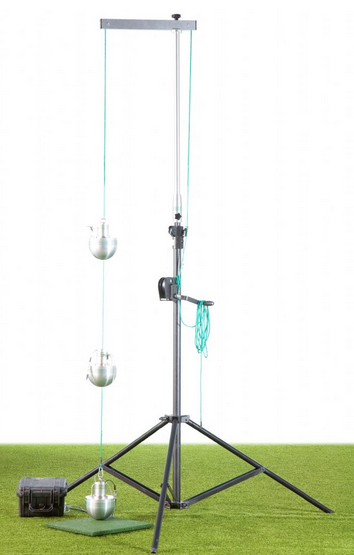The safety of playground surfacing with standard UNI EN 1177
(Pubbl. 09/03/2023)Tag:
safety
Play is a key element for man, representing one of the aspects most capable of allowing us to understand the nature of our species. Playing is enjoyable and lets us release energy and obtain the knowledge and skills needed for adult life, but since at times even playing can be hazardous, it is essential to play safely.
Children’s playground equipment is regulated by European standards.
Compliance with these standards is a precaution not only for the manufacturer and the installer, but also for the client, whether public or private.
The few severe injuries occurring in playgrounds are mainly attributable to falls in which the child hits his head on the playground surfacing.
As a result, the CEN (European Committee for Standardization) has chosen to make its priority the reduction of the likelihood of serious head injuries caused by a fall from playground equipment, specifying that standard UNI EN 1176 be used in conjunction with UNI EN 1177:2019 that provides a method to assess the effectiveness of impact attenuating playground surfacing.
What the standard says
In this standard, the severity of injury resulting from an impact to the head is quantified in terms of two physical quantities:
Limiting the HIC value to a maximum of 1 000 is equivalent to setting the following statistical risk levels for an average male adult:
A variety of materials, both natural and synthetic, may be used as impact attenuating surfacing with different attributes and performance.
 The test apparatus specified by standard UNI EN 1177 for characterisation of surfacing comprises:
The test apparatus specified by standard UNI EN 1177 for characterisation of surfacing comprises:
To determine the Critical Fall Height (CFH], i.e. the fall height beyond which the surfacing starts to be hazardous, we must interpolate the curves to obtain the drop height equivalent to an HIC of 1 000 and drop height equivalent to a gmax of 200.
The greater the drop height equivalent to an HIC of 1000, the greater the effectiveness of the surfacing.
For example, if a certain material has a Critical Fall Height (CFH) of 4 m, it means that this threshold must not be exceeded inside the playground because, otherwise, the Head Injury Criterion (HIC) will exceed 1000 and, as a result, the likelihood of serious head injuries caused by an accidental fall would be too high.

The Istituto Giordano Security and Safety division can carry out the test in accordance with the procedure specified by standard UNI EN 1177:2019.
For further details or to receive a quotation, please contact Andrea Bruschi (0541 322388 – a.bruschi@giordano.it)
For those wishing to study the subject of playground safety in more detail, here is a list of several important reference standards making up the UNI EN 1176 family:
Children’s playground equipment is regulated by European standards.
Compliance with these standards is a precaution not only for the manufacturer and the installer, but also for the client, whether public or private.
The few severe injuries occurring in playgrounds are mainly attributable to falls in which the child hits his head on the playground surfacing.
As a result, the CEN (European Committee for Standardization) has chosen to make its priority the reduction of the likelihood of serious head injuries caused by a fall from playground equipment, specifying that standard UNI EN 1176 be used in conjunction with UNI EN 1177:2019 that provides a method to assess the effectiveness of impact attenuating playground surfacing.
What the standard says

In this standard, the severity of injury resulting from an impact to the head is quantified in terms of two physical quantities:
- Head Injury Criterion (HIC) with a limiting value of HIC = 1 000;
- Peak acceleration level with upper limit gmax = 200g (g = acceleration due to gravity).
Limiting the HIC value to a maximum of 1 000 is equivalent to setting the following statistical risk levels for an average male adult:
| HIC = 1000 | Injury type | Probability |
| critical | 3 % | |
| severe | 18% | |
| serious | 55% | |
| moderate | 89% | |
| minor | 99,5% |
A variety of materials, both natural and synthetic, may be used as impact attenuating surfacing with different attributes and performance.
 The test apparatus specified by standard UNI EN 1177 for characterisation of surfacing comprises:
The test apparatus specified by standard UNI EN 1177 for characterisation of surfacing comprises:
- an aluminium headform fitted with an accelerometer aligned to measure 3 axes;
- a release system;
- a device for measuring the effective Free Height of Fall (FHF);
- a signal transmission system and processing software.
To determine the Critical Fall Height (CFH], i.e. the fall height beyond which the surfacing starts to be hazardous, we must interpolate the curves to obtain the drop height equivalent to an HIC of 1 000 and drop height equivalent to a gmax of 200.
The greater the drop height equivalent to an HIC of 1000, the greater the effectiveness of the surfacing.
For example, if a certain material has a Critical Fall Height (CFH) of 4 m, it means that this threshold must not be exceeded inside the playground because, otherwise, the Head Injury Criterion (HIC) will exceed 1000 and, as a result, the likelihood of serious head injuries caused by an accidental fall would be too high.
The Istituto Giordano Security and Safety division can carry out the test in accordance with the procedure specified by standard UNI EN 1177:2019.
For further details or to receive a quotation, please contact Andrea Bruschi (0541 322388 – a.bruschi@giordano.it)
For those wishing to study the subject of playground safety in more detail, here is a list of several important reference standards making up the UNI EN 1176 family:
- UNI EN 1176-1:2018 covering general safety requirements and test methods;
- UNI EN 1176-2:2019 dealing with swings;
- UNI EN 1176-3:2018 dealing with slides;
- UNI EN 1176-4:2019 dealing with cableways;
- UNI EN 1176-5:2019 dealing with carousels;
- UNI EN 1176-6:2019 covering rocking equipment
- UNI EN 1176-7:2020 providing guidance on installation, inspection, maintenance and operation of playground equipment.







 Do you need more information about our services?
Do you need more information about our services?